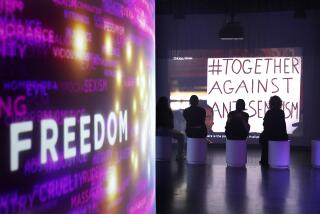50 years after Watts: ‘There is still a crisis in the black community’
- Share via
In 1965, as Watts erupted in violent unrest, Tony Welton and his teenage friends walked by a market on Avalon Boulevard and Imperial Highway. They cursed it for the way it sold spoiled meat and rotten fruit to customers without the money or means to shop elsewhere.
The thought crossed their minds that they should burn it down.
They didn’t have to light a match. The market was one of the first businesses destroyed as bands of rioters took control of the streets, attacking white motorists and torching buildings while snipers shot at firefighters who tried to tamp down the flames.
As he sat pushing knights and pawns across a chessboard two weeks ago at the Lancaster Senior Center, Welton, 68, reflected on how the events 50 years ago this week shifted and failed to shift the racial power equation in America.
After the riots, he said, he felt a sense of hope that things would change quickly because, at last, whites had seen the reality of how blacks lived.
Now, like many, he points to recent unrest in Ferguson, Mo., and Baltimore as reason to question how far the country has really come.
“I thought we would have elevated ourselves into more... unity,” he said.
::
A measure of support followed the riots. “You had more people in the general community who became sensitized to the plight of African Americans,” says former Los Angeles County Supervisor Yvonne B. Burke, who served on the staff of the McCone Commission, which studied the root causes of the upheaval.
The complexity of those causes made solutions daunting.
Watts had not been the first race riot of the civil rights era. In the summer of 1964, black people lashed out in seven northeastern cities, leaving five people dead.
But the conditions in South Los Angeles were rigged for a bigger detonation.
Great waves of black migrants had arrived from Texas and Louisiana during World War II to claim jobs in the defense industries. The Jordan Downs and Imperial Courts housing projects in Watts were built to house those workers.
Between 1940 and 1965, the black population in Los Angeles County jumped from 75,000 to 650,000, with two-thirds in the South Los Angeles area.
The frustration that black people endured all over the country intensified in Los Angeles, as bleak reality dashed the Southern migrants’ high expectations.
Public transportation from South Los Angeles to the Hughes Aircraft plant in Culver City or the General Motors facility in Panorama City was nearly impossible. And in peacetime, those jobs slowly evaporated. Many men idled as their wives trudged off to work as housekeepers in the white neighborhoods surrounding them.
Feeling under siege from an overwhelmingly white police force, black residents rioted in part, historians have noted, against powerlessness.
Burke says that greater political power did come in the years after the riots as coalitions between the black community and other liberal constituencies, including Hollywood, pushed black leaders into elective office.
In 1969, Councilman Tom Bradley nearly unseated Mayor Sam Yorty, who rallied by raising fears of another riot and claiming that Bradley was “appealing to black militants and left-wing radicals.”
The fear-mongering didn’t work in 1973, when Bradley beat Yorty in a landslide. He would go on to serve five terms before retiring.
But by the late 1980s, stagnant economic conditions and gang warfare were pushing many African Americans out of Los Angeles and back to Texas, Louisiana and Atlanta, or to scattered exurbs such as San Bernardino, the Moreno Valley and the Antelope Valley, diffusing the budding power base.
Chris Jordan is among those who left. He now lives in upscale Chino Hills, a halfway point between a contracting job in Palms Spring and Watts, where he is the executive director of a nonprofit organization seeking to redevelop the old commercial corridor along 103rd street that became “Charcoal Alley” during the riots.
Jordan was a toddler, living with his family at 120th Street and Central Avenue in 1965.
Among the riots’ unfortunate consequences, he says, was an even more aggressive police presence.
As a boy, he was always taught, ‘Don’t look at the cops.... It was always a relationship of fright,” he says.
In two decades of living in Chino Hills, he has never interacted with the police.
Yet a half-century after the riots, he teaches his two teenage sons the same lessons his parents taught him. He role-plays with the 15- and 16-years olds to teach them how to “de-escalate” an encounter with law enforcement — who, by definition, wield the most direct form of power.
“You would think you won’t have to have these conversations in 2015,” he said. “But you do. We must.”
Harvard University professor Henry Louis Gates argues that continued racial tension between police and African Americans actually stems, in part, from the battles on Los Angeles streets in 1965.
“Watts,” he says, “brought the economic nature of oppression ... to the nation’s attention [and marked] the beginning of the end of the civil rights movement and the birth of a more subtle and nuanced and complex kind of analysis.”
And, Gates says, it also brought about a more militarized form of policing, as LAPD Chief William Parker and his successors’ tactics for stamping out future riots were adopted by police agencies nationwide.
The tension between police and African Americans, combined with poverty and racism that helped set off Watts, is still smoldering says Patrisse Cullors, a native Angeleno and co-founder of the Black Lives Matter movement.
She says: “Fifty years ago, there were young black people trying to fix that crisis and put it on America’s radar. There is still a crisis in the black community.”
Farajii Muhammad, 36, an activist and radio host in Baltimore, also draws connections between this moment of #BlackLivesMatter protest and the time when people shouted “Burn, baby, burn.”
Yes, he acknowledges, black people have made tremendous strides, rising into professions and positions of leadership. But he adds that any visitor to Baltimore today “would see Watts ... because of the same economic conditions, the same employment conditions, the lack of educational opportunities and just the overall culture of violence and hopelessness.”
::
At least some who witnessed the riots see the 50-year struggle to gain power from a personal as well as political perspective.
Gwendolyn “Fay” Butler, 72, was a young mother with a baby, living near the focal point of the growing chaos.
Anger, fire and fear were not new to her.
Her family had moved to Jordan Downs from Shreveport, La., in 1943, and then on to other parts of South Los Angeles. Her mother made her come inside before the street lights flickered to life because groups of men from Compton and other then-white communities drove through neighborhoods throwing bottles, rocks and the occasional Molotov cocktail.
One day early in the rioting, her first husband and a friend came home with a delivery truck full of washers, dryers and refrigerators they had stolen it from the White Front discount store.
She made them take it all back.
For Butler, the uprisings’ benefits would be indirect.
Perseverance landed Butler a job in a downtown law firm’s mail room, and she took her boss’ advice to read everything she came across — interrogatories, depositions, everything.
Her knowledge earned her a promotion to legal secretary and she eventually moved to Southern California Edison, where she worked for 22 years, rising into management in the human resources division.
Butler, who now lives with her second husband in Lancaster, points to one incident as a small but significant example of how her own sense of power changed.
In 1966, she was at a bus stop on Central Avenue when a white woman and her son tried to push their way on ahead of her.
“What are you doing?” Butler asked.
“I’m white,” the woman offered matter-of-factly.
Before the riots, Butler says, she would have kept quiet.
That afternoon, she said: “You’re in the wrong place.”
The white woman moved to the back of the line.
With the rallying cry “Burn baby burn” still echoing in peoples’ minds, blacks in South Los Angeles — or anywhere — were not going back to “Yes, sir. No, ma’am.”
MORE:
Death, destruction, looting: A tally of the Watts riots
The Watts riots: What the editorial board thought then
10 ways to explore the complicated legacy of Watts through literature
More to Read
Sign up for Essential California
The most important California stories and recommendations in your inbox every morning.
You may occasionally receive promotional content from the Los Angeles Times.












